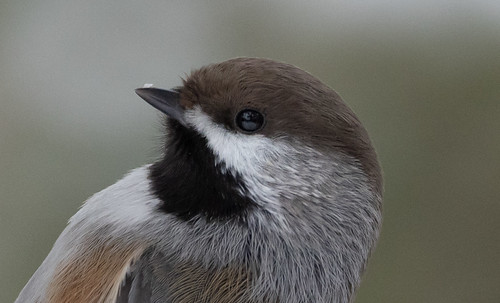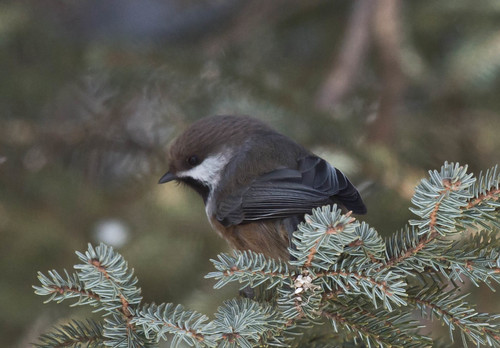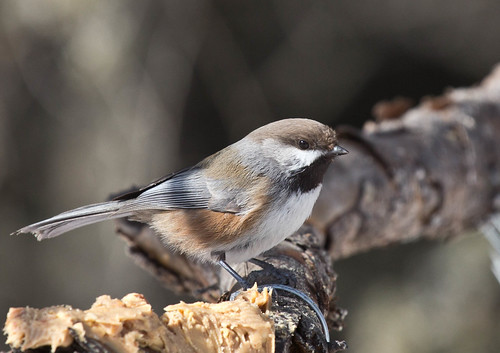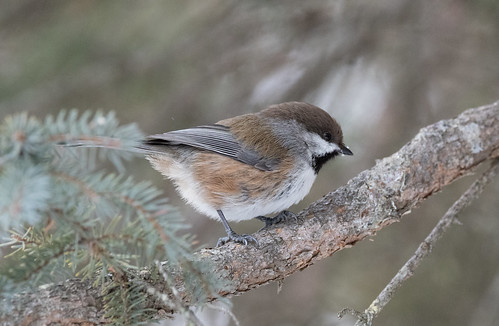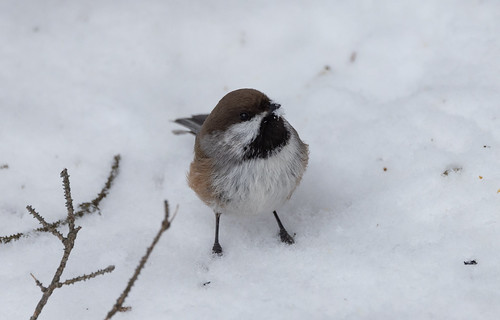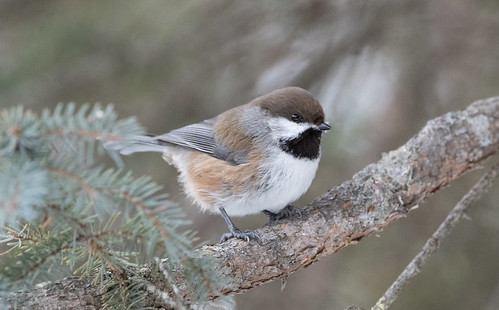As Russ was finishing up his Ph.D. in 1980 and starting to look at job options, I was pretty sure I’d be happy wherever we ended up. I was a teacher at the time and knew I could find some kind of job and plenty of birds just about anywhere—his job was more limiting geographically. I suspected I’d be happiest if we settled somewhere within the range of Black-capped Chickadees, but that wasn’t too constraining—that would have given us Alaska, most of Canada, all the northern states, and swaths of the Appalachians and Rockies.
 |
| Range map from the Cornell Lab's All About Birds |
I didn’t voice that as an actual need—I knew there’d be at least some kind of chickadee just about anywhere we went.
When he got a job opportunity in Duluth, though, I started lobbying in earnest. Imagine living where so many warblers nested! Where in winter I’d have a good chance of seeing Great Gray Owls! Northern Hawk Owls! Boreal Owls! Hawk Ridge Nature Reserve—a world-class migration observation site—was in Duluth. Best of all, northern Minnesota was home to TWO chickadees—abundant Black-capped Chickadees and also Boreal Chickadees.
 |
| Range map from the Cornell Lab's All About Birds |
I don’t know if my lobbying made an impact—one huge draw Duluth held for Russ was that a few years before, his parents had retired to Port Wing, Wisconsin, little more than an hour’s drive from Duluth, and a beautiful drive at that. That was a huge perk for me, too—I loved Russ’s parents and knew it would be wonderful for our children to live near their grandparents, but I also deeply loved Port Wing, where I’d already birded many times starting in 1975, my first fall of birding. Le Conte’s Sparrows nested in the fields abutting Russ’s parents’ property, and I’d staked out lovely birding routes where I could see 80 or more species on a good day in spring or early summer.
By the time we moved to Duluth at the end of March 1981, I was pregnant for the first time. We were renting, and life was hectic as we looked for a house and dealt with so many major transitions, but my one urgent birding goal was to see a Boreal Chickadee, so as soon as I met him, I asked Kim Eckert where I could find one. He suggested an easily accessed spot just north of Two Harbors, so Russ and I went there during his lunch hour the next day. We found a pair quite easily, but they were way high up in a distant spruce tree and I was going through a nasty bout of morning sickness, so I didn’t enjoy this splendid lifer nearly as much as I should have.
If only I’d been more patient! On November 17 of that very same year, a Boreal Chickadee showed up at my peanut butter feeder, and it kept coming for a month. That was as close as I’ve come to getting a lifer on Peabody Street.

The chickadee family originated in the Old World, the first ones reaching America via the Bering land bridge during the Pleistocene. The Boreal Chickadee is most closely related to the Gray-headed Chickadee (once called the Siberian Tit) and the Chestnut-backed Chickadee of the West Coast and Pacific Northwest.
As boreal forest specialists, Boreal Chickadees live up to their name. They are usually found in mature coniferous forests—primarily spruce and balsam fir, often near water. In western Canada, they also live in mixed and deciduous forests, and in Alaska are frequently found in willow and alder woodlands as well as spruce. Here in Minnesota, except when visiting a feeder, they spend most of their time at the tops of spruce trees, among the cones. Their brown cap bleeds into their dark back, so despite their longer tail, from a distance at the top of a black spruce, their dark, low-contrast backside makes them look a bit more like a Red-breasted Nuthatch than a chickadee. They’re far less vocal than Black-capped Chickadees, with no whistled songs, and their chickadee calls are quiet and wheezy, making them even harder to notice.
I’ve had Boreal Chickadees in my yard just four or five times. In 1987, three showed up much of the winter. Two were clearly a pair, and when they disappeared in early spring, the third seemed lonely—suddenly it would fly close whenever I went out to fill the feeders as if even an oversized mammal who couldn’t make a decent Boreal Chickadee vocalization to save her life was a better companion than no one at all.
Boreal Chickadees are hardly a typical backyard bird in Duluth—the few times I have had them here, birding guides brought groups to my yard to see them. In the center of their range in Canada, where they’re more likely to turn up at feeders, their tolerance of people led to several affectionate nicknames, such as tom-tit, chick chick, and fillady.
March 2 is the anniversary of my going out on my very first birding excursion, on which the only bird I saw was a Black-capped Chickadee—my first lifer. So I call March 2 “Chickadee Day,” and make it a point to pay special attention to chickadees. On Chickadee Day 2004, I was feeding mealworms to my chickadees out my home office window when I saw an outlier—a Boreal Chickadee! I didn’t spot that one at my feeders—in general, Boreal Chickadees are far less interested in feeders than Black-capped Chickadees are. This one must have been moving about at winter’s end, and temporarily joined up with one of the Black-capped flocks. It was thrilling to see not just one but two different chickadees on Chickadee Day!
Ever since my first encounter with a Boreal Chickadee in my backyard in 1981, I’ve noticed that they’re attracted to peanut butter. The winter I had three, they came to suet as well, but they definitely are more drawn to peanut butter. When birders started setting up bird feeding stations at the Sax-Zim Bog, some of them started smearing peanut butter on tree trunks and branches at the Admiral Road feeders, and that became an extremely reliable spot for seeing Boreal Chickadees. But except when they’re right at the feeders, they’re hard to pick out even when they’re in the nearest trees.
For some reason, this year these tiny mites have been hard to find on Admiral Road—instead they’re showing up at the end of Gray Jay Way—a lovely trail starting at the Sax-Zim Bog Welcome Center. I took that hike on Monday, and sure enough, a little group of three showed up a few minutes after I arrived. I’d planted myself near one feeder and despite the overcast day’s low light, got some lovely photos.
Seeing them close up, lovely memories of other encounters flooded into my mind, making me realize yet again that I left someone off my Top Ten Favorite Birds of all time. The Black-capped Chickadee will always be #1, but now the Boreal Chickadee is up there, too, in that now 14-way tie for fifth place. For me, to know a bird really is to love it.
